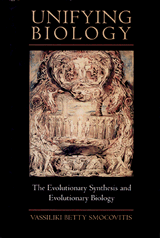
Was
Darwin
Wrong?
 Was Darwin Wrong? |
Home | Intro | About | Feedback | Prev | Next |
|
The neo-Darwinian Synthesis:
| ||||||||||||||||||||||

'Unifying Biology. The Evolutionary Synthesis and Evolutionary Biology' by Vassiliki Betty Smocovitis. reviewed by Gert Korthof 6 Sep 2001 |
||||||||||||||||||||||
|
Darwin published his Origin of Species in 1859. It was a synthesis of all the relevant biological knowledge of his time. Darwin's synthesis included palaeontology, systematics, morphology, embryology, geology and animal and plant breeding. Genetics did not exist at Darwin's time. Mendel, the founder of modern genetics, was rediscovered only in 1900. Darwin had a theory of heredity that included the heredity of acquired characteristics. This kind of heredity is completely rejected by today's geneticists. Genetics is now a solid and central discipline in the life sciences and is radically different from Darwin's theory of heredity.
However Darwin's theory of evolution is accepted by virtually all biologists. So to integrate the new science of genetics into the Darwinian framework a lot of work needed to be done. This work took place between 1920-1950. The project is called 'The Evolutionary Synthesis', and its product is called 'neo-Darwinism'. The history of the Synthesis is the subject of Smocovitis' book.
The Neo-Darwinian SynthesisOne of the remarkable historical facts I learned from this book is which biological disciplines were included, as well as which were excluded. Mendelian genetics and Population genetics were the two most important disciplines that were included. The development of genetics solved many longstanding disputes about heredity.Mendelian genetics showed that characteristics inherited as discrete, nonblending factors and that blending inheritance (accepted in Darwin's time) was wrong and therefore must be rejected. Secondly, Lamarckian inheritance (also accepted in Darwin's time) was rejected because nobody had demonstrated it conclusively and it contradicted the new genetics. Population genetics was going to determine the very definition of evolution: the change of gene frequencies in populations over generations. Further all kind of 'soft' theories such as mysticism, vitalism, supernatural design, directed evolution and progressive evolution were judged incompatible with this 'hard' mathematical science and were rejected. So a sifting out process occurred. One could even say that neo-Darwinism dominated by 'elimination of the competition'. These events, I think, explain a lot of later criticism directed at the neo-Darwinian synthesis (4). A number of biological subdisciplines were not included in the Synthesis either (see figure): embryology (1), biochemistry (2), medicine (3), microbiology, ecology. Among the reasons for this exclusion were that people in those disciplines had different type of problems and methods to solve those problems. They could not easily integrate their practices with the evolutionary paradigm. An interesting example is embryology or developmental biology. Evolution & Developmental BiologyI will illustrate the 'deep intellectual divide' between Developmental biology (embryology) and Evolutionary biology based on Rudolf Raff's analysis (1):
Developmental biologists searched for immediate causes of the unfolding embryo; they didn't need evolution. According to Ernst Mayr embryology was absent from the Synthesis because embryologists simply did not want to be included. Furthermore, evolution was perceived as a non-experimental science (p198). Mayr noted already that embryologists were only interested in proximate rather than ultimate causes. However, before embryology could integrate with evolution, another obstacle needed to be removed: the reciprocal antipathy of geneticists and embryologists (5). The integration of Evolution and Developmental Biology ('Evo-Devo') is more than just the next step of the Synthesis. It promises to solve a hard problem in neo-Darwinism: how mutations and gene frequencies (microevolution) translate into changes of the forms of animals and plants (macroevolution). Michael Behe, Biochemistry & EvolutionRight in the preface of his famous Darwin's Black Box Michael Behe complains that there has been virtually no attempt to account for the origin of specific complex biochemical systems. Behe devoted a chapter to The Journal of Molecular Evolution. So there is a journal and clearly biochemists started working on evolution. Apparently they did not work on Behe's problem. However, could it be that Evolution is an unfinished synthesis? Could it be that there are no models of the origin of complex biochemical systems because biochemists think that those models are too speculative and cannot be experimentally tested? Just as embryologists perceived evolution as a non-experimental science? Michael Behe had his own answer (2). Smocovitis' book however could suggest some historical reasons for the failure of biochemistry to explain to origin of complex biochemical systems. Knowing the historical and sociological background of the neo-Darwinian Synthesis and the different nature of the disciplines helps to understand the partial integration of Developmental biology, Biochemistry and Medicine into the Darwinian framework.Is Smocovitis' book unorthodox or orthodox history of science? It is orthodox in its full acceptance of evolution, and unorthodox in its emphasis on individual scientists and the role of social groups in creating scientific knowledge (known as contextualism). Despite this unorthodox approach Smocovitis' approach to science is quite natural. She developed a philosophy of science that integrates both external and internal influences on science. |
||||||||||||||||||||||
Notes
Further Reading
Other Reviews
|
| Feedback | home: wasdarwinwrong.com | wasdarwinwrong.com/korthof52.htm |
| Copyright © G.Korthof 2001. | First published: 8 June 2001 | Updated: 6 Sep 01 F.R.: 1 May 2007 |